
Snus is a tobacco product, originating from a variant of dry snuff in early 18th-century Sweden. It is placed between the upper lip and gum for extended periods, as a form of sublabial administration. Snus is not fermented. Although used similarly to American dipping tobacco, snus does not typically result in the need for spitting and, unlike naswar, snus is steam-pasteurized.

Soho Square is a garden square in Soho, London, hosting since 1954 a de facto public park let by the Soho Square Garden Committee to Westminster City Council. It was originally called King Square after Charles II, and a much weathered statue of the monarch has stood in the square, with an extended interruption, since 1661, one year after the restoration of the monarchy.

The Pantheon was a place of public entertainment on the south side of Oxford Street, London, England. It was designed by James Wyatt and opened in 1772. The main rotunda was one of the largest rooms built in England up to that time and had a central dome somewhat reminiscent of the celebrated Pantheon in Rome. It was built as a set of winter assembly rooms and later briefly converted into a theatre. Before being demolished in 1937, it was a bazaar and a wine merchant's show room for over a hundred years. Marks and Spencer's "Oxford Street Pantheon" branch, at 173 Oxford Street now occupies the site.
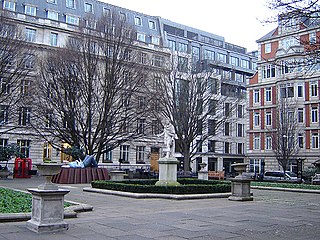
Golden Square, in Soho, the City of Westminster, London, is a mainly hardscaped garden square planted with a few mature trees and raised borders in Central London flanked by classical office buildings. Its four approach ways are north and south but it is centred 125 metres east of Regent Street and double that NNE of Piccadilly Circus. A small block south is retail/leisure street Brewer Street. The square and its buildings have featured in many works of literature and host many media, advertising and public relations companies that characterise its neighbourhood within Soho.
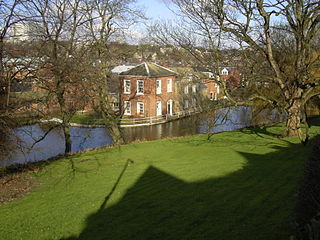
Wilsons of Sharrow, now named Wilsons & Company (Sharrow) Ltd, based at Sharrow Mills in the Sharrow district of Sheffield, United Kingdom, is a manufacturer of snuff tobacco since 1737. Since 1982 Wilsons now also manufactures the renowned Fribourg & Treyer snuff blends who were producing snuff since 1720.

Snuff is a type of smokeless tobacco product made from finely ground or pulverized tobacco leaves. It is snorted or "sniffed" into the nasal cavity, delivering a swift hit of nicotine and a lasting flavored scent. Traditionally, it is sniffed or inhaled lightly after a pinch of snuff is either placed onto the back surface of the hand, held pinched between thumb and index finger, or held by a specially made "snuffing" device.

Montrose House is a late 17th-century Grade II* listed building at 186 Petersham Road, Petersham in the London Borough of Richmond upon Thames.

Sharrow Mills are a collection of industrial buildings in Sheffield, England, which have been used for the production of snuff by the firm of Wilsons of Sharrow since the mid 18th century. The mills stands on the Porter Brook in the Sharrow Vale area of the city, just off Ecclesall Road.
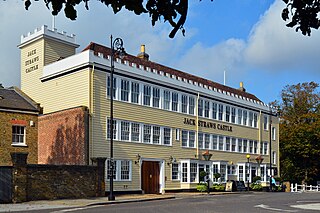
Jack Straw's Castle is a Grade II listed building and former public house in Hampstead, north-west London, England.

Thayer Street is a street in the Marylebone district of the City of Westminster, London, that contains four listed buildings.
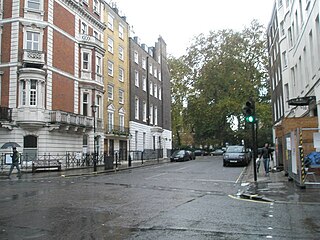
Hinde Street is a street in the Marylebone district of the City of Westminster, London, that contains the Hinde Street Methodist Church and was home to the novelist Rose Macaulay until her death.

Mount Street is an east–west, quite narrow, archetypal street in the Mayfair district of the City of Westminster, London fronted by many mid-rise buildings, mostly of a narrow frontage. The sides of two very grand hotels flank part of either end of the street. Small, high-end property businesses, investment funds and accountancy businesses punctuate the buildings as well as a row of traditional businesses and conversion-style mansion block apartments or, more generally, authentic such homes.
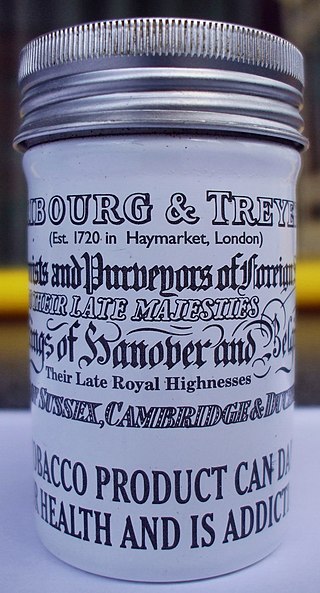
Gottlieb Augustus Treyer (1790–1869) was a German-born British snuff manufacturer and retailer.

Bolton Street is a street in the City of Westminster, London. The street runs from Curzon Street in the north to Piccadilly in the south.

Stratton Street is a street in the Mayfair district of the City of Westminster, London. It runs from Berkeley Street in the north to Piccadilly in the south.

Mayfair Place is a street in the City of Westminster, London. The street joins Stratton Street to Berkeley Street.

The Cheshire Cheese is a public house at 5 Little Essex Street, London WC2, on the corner with Milford Lane.

Milford Lane is a narrow street in the City of Westminster that runs from Strand in the north to a brief walkway section leading to Temple Place in the south. It is joined by Little Essex Street and Essex Street on its eastern side. Maltravers Street once joined the lane to Arundel Street, but ceased to exist when building work at 190 Strand was completed.

Blossom's Inn was a tavern which stood in Lawrence Lane in the City of London from the 14th century until 1855. It became a substantial coaching inn and was used as a staging post by carriers of goods. In the 19th century, the lease was bought and it became the parcel depot of the Great Eastern Railway. Its name was used for a major property development at the end of the 20th century and the site is now part of the large complex of 30 Gresham Street.




















